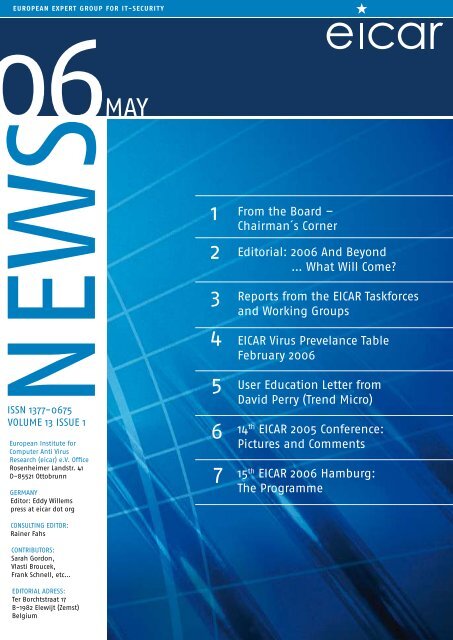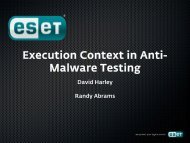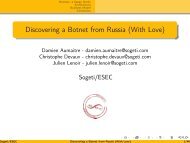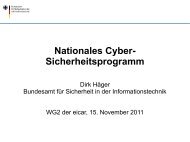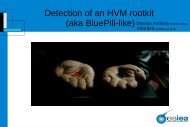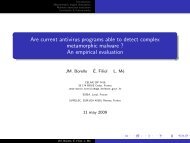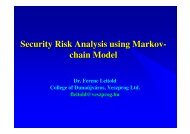Volume 13 Issue 1 (pdf, 352 - Eicar
Volume 13 Issue 1 (pdf, 352 - Eicar
Volume 13 Issue 1 (pdf, 352 - Eicar
Create successful ePaper yourself
Turn your PDF publications into a flip-book with our unique Google optimized e-Paper software.
6MAY<br />
July<br />
6<br />
NEWS<br />
ISSN <strong>13</strong>77-0675<br />
VOLUME <strong>13</strong> ISSUE 1<br />
European Institute for<br />
Computer Anti Virus<br />
Research (eicar) e.V. Office<br />
Rosenheimer Landstr. 41<br />
D-85521 Ottobrunn<br />
GERMANY<br />
Editor: Eddy Willems<br />
press at eicar dot org<br />
CONSULTING EDITOR:<br />
Rainer Fahs<br />
CONTRIBUTORS:<br />
Sarah Gordon,<br />
Vlasti Broucek,<br />
Frank Schnell, etc…<br />
EDITORIAL ADRESS:<br />
Ter Borchtstraat 17<br />
B-1982 Elewijt (Zemst)<br />
Belgium<br />
7<br />
From the Board –<br />
Chairman´s Corner<br />
Editorial: 2006 And Beyond<br />
… What Will Come?<br />
Reports from the EICAR Taskforces<br />
and Working Groups<br />
EICAR Virus Prevelance Table<br />
February 2006<br />
User Education Letter from<br />
David Perry (Trend Micro)<br />
14 th EICAR 2005 Conference:<br />
Pictures and Comments<br />
15 th EICAR 2006 Hamburg:<br />
The Programme
1<br />
DiversityAssimilation?<br />
EICAR is a truly international organisation with membership<br />
from all around the globe. The Board is an<br />
assembly of six representatives from four different<br />
nations and we are geographically situated in three<br />
different continents – Europe, North America and<br />
Australia. The annual conference is planned and<br />
managed with an international team from “down<br />
under”, while business development and administration<br />
resides in Germany. This situation bears some<br />
inherent challenges in terms of inter relationship and<br />
communication.<br />
The diversity not only of Board members, AR, be it in<br />
the area of conference but also of key contributors<br />
within EIC preparation or paper review and selection,<br />
the management of the organisation as such or the<br />
outside representation via our web-page, requires a<br />
great deal of respect and consideration for the others.<br />
All these individuals with their specific backgrounds<br />
and expertise, with their own way of doing things,<br />
their interpretation, perception and way of communication<br />
deserve the full respect of the others.<br />
Whenever we speak about diversity, we speak about<br />
gender, race, ethnic origin, nationality, age, religion,<br />
as well as background, education and behaviour.<br />
What we really speak about is the distinctions that<br />
make people different from each other. Everybody<br />
seems to agree that people are different and we<br />
hear people saying that we should embrace these<br />
differences because these differences are what really<br />
make us individuals.<br />
The real issue than is the integration of single individuals<br />
into teams. How to esteem diversity without<br />
trying to assimilate, make them like us?<br />
Diversity is foremost all about accepting that it concerns<br />
each and every one of us recognising that we<br />
are different to some and similar to others, meaning<br />
we are part of the mix.<br />
It is a definitely challenge requiring quite a bit of<br />
sensibility to achieve common goals in an environ-<br />
FROM THE BOARD<br />
CHAIRMAN´S CORNER<br />
(By Rainer Fahs (RFA))W W W<br />
ment of great diversity. It is however very rewarding<br />
to be part of a team that despite of diversity works<br />
together towards a common goal.<br />
Once we have agreed on common objectives we have<br />
to find the best way to convert objectives into individual<br />
goals and assign tasks and responsibilities in<br />
accordance to the expertise of each contributing individual.<br />
And here we are again, there are individuals,<br />
meaning we still have diversity. In consequence we<br />
(every one in the team) have to recognise the expertise<br />
of the others. This is inherently difficult since every<br />
individual knows what he/she is capable of, but that<br />
is an intangible asset that is not measurable. What<br />
we are calibrated for is our achievements, which are<br />
visibly.<br />
I think for the last couple of years, we have managed<br />
pretty well. We where able to take new key players<br />
on board and we succeeded to integrate them into<br />
the complicated processes. This in return resulted in<br />
the exploitation of fresh expertise, which in return<br />
has changed the scope and objectives of EICAR as an<br />
organisation.<br />
Still concentrating on our core business, we have<br />
managed to gain also considerable reputation in the<br />
area of security management. However, the visibility<br />
of related activities is associated with our very active<br />
task forces on RFID, Wireless LAN and Content Security,<br />
which are concentrated mainly in Germany.<br />
One of the reasons to get the EICAR conference back<br />
to Germany was to provide members of these active<br />
TF/WGs also a platform to represent their activities<br />
to a wider audience.<br />
Recognising somewhat the consequences of that, I<br />
was very happy that we could get a PR professional<br />
on board who took on the responsibility of business<br />
development for EICAR.<br />
Dealing with PR in a professional way was quite an<br />
experience for most of us over the past year, but if we
2<br />
look back now, we can only conclude that it was<br />
worth going this maybe occasionally thorny path.<br />
Based on a number of activities and a great deal of<br />
networking, we have succeeded in promoting EICAR<br />
and its activities to a much wider audience than only<br />
the core AV researchers.<br />
EICAR has gained a reputation, which again has<br />
become an obligation for us. At our conference this<br />
year we are bridging for the first time technically high<br />
quality and academic presentations to presentations<br />
of interest for the management level responsible for<br />
the implementation of security policy and mechanism.<br />
This is an opportunity for every one of us. The high<br />
standard of our conference is what gets experts from<br />
around the world to submit papers or sign up to<br />
participate. If we want to keep that high standard, we<br />
must continue to work as one team, respectful recognising<br />
diversity, but striving for common goals.<br />
FROM THE DESK OF SCIENTIFIC<br />
DIRECTOR AND PROGRAM CHAIR<br />
(Vlasti Broucek)<br />
The EICAR 2006 call for papers have been published<br />
at the end of August 2005 and we have called for<br />
submissions in three categories - non-peer reviewed<br />
research papers (also called industry), peer reviewed<br />
papers (also called academic) and posters. Based on<br />
the submissions, well appointed program committee<br />
decided to accept 18 non-peer reviewed papers and<br />
after double/triple blind review of academic papers<br />
accepted 12 peer reviewed papers. Out of these twelve<br />
papers, seven were also offered journal publication.<br />
During the selection process, approximately about<br />
one third of submissions were rejected as either not<br />
suitable for the EICAR conference or for not being of<br />
sufficient research standard. Unfortunately, we have<br />
seen a significant drop in number of to 2005. On the<br />
other hand, the papers submitted by both academics<br />
and non-academics had generally higher standard<br />
than in 2005 and rejection rate was lower.<br />
Unfortunately, only two posters have been submitted.<br />
One of them has been deemed not suitable for the<br />
conference and as a result poster session has been<br />
FROM THE BOARD – CHAIRMAN´S CORNER<br />
cancelled. It suggests that there is not enough interest<br />
in this way of presenting in our field of expertise.<br />
The high quality and wide scope of the papers yet<br />
again confirm growing quality of the EICAR conference<br />
and broadening of it scope. While the majority of<br />
papers can still be classified as AV related, nearly all<br />
of them can also be classified in other categories such<br />
as Critical Infrastructure Protection, Legal, Privacy and<br />
Social <strong>Issue</strong>s of ICT Security, ICT Security and Policy<br />
Management etc.<br />
The program for the conference is nearly ready to be<br />
published. The selected papers have been grouped<br />
according to the topic and will be presented in these<br />
groups. Academic (peer reviewed) papers will be presented<br />
first in each relevant group followed by nonpeer<br />
reviewed papers.<br />
It also appears that the once successful Graduate<br />
Workshop is not attracting an adequate number of<br />
students. While there is still time to enrol, hitherto<br />
the program committee did not receive a single submission.<br />
The program of the Professional Workshop also suffers<br />
fall off interest from speakers this year, but there has<br />
been interesting developments in the last few days. I<br />
can now confirm that we will have a very interesting<br />
session on „Security and Privacy Risks in Biometric<br />
Deployments“ by Elizabeth Bates and Dr Bill Hafner<br />
from USA. This should also help to form proposed TF<br />
on Biometrics proposed by Elizabeth and Bill. This<br />
should cover the Sunday morning session and another<br />
possible session, most probably on Network Traffic Visualisation,<br />
is currently being discussed with possible<br />
presenters.<br />
TF AND WG REPORTS<br />
(Manuel Hüttl)
3<br />
RFID Task Force<br />
The RFID Task Force has been very successful over the<br />
past two years. We saw an interest of different markets<br />
and the number of participants is still growing.<br />
The industry attends with leading companies like<br />
Microsoft, SUN Microsystems, SAP, Intel – not just typically<br />
IT-Security vendors. Officials like the Federal Data<br />
Protection Commissioner from Germany joined as well<br />
as huge retail organisations like Metro AG. We also<br />
welcomed standardisation specialists like<br />
GS1 (EPCGlobal).<br />
So there is a nice mixture of different interest groups<br />
– an era sometimes not easy to handle by the way.<br />
We defined a first target: to provide a guideline for<br />
organisations that do want to implement the RFID<br />
technology and we focused on data protection and<br />
related privacy issues. So for example, a company<br />
could use this guideline as an appendix for project<br />
contracts.<br />
The next step is related to the issue of person-related<br />
data connected to the communication between a<br />
RFID tag and reader. We are facing classical IT-Security<br />
issues here to protect this critical information – from<br />
access control to storage.<br />
We are already working on a guideline that covers<br />
those IT-Security issues in RFID-scenarios from the<br />
perspective of technology, organisation, legislation<br />
and psychology.<br />
One of our next goals is to extend the activities to<br />
a pan-European level. Because of the complicated<br />
legislation issues, we were starting in Germany.<br />
Task Force „Content Security“<br />
We are very pleased to announce that we finally have<br />
a new TF in place. After talking to industry and other<br />
experts, we noticed a growing demand for this platform.<br />
We can also happily report that we succeeded<br />
in winning Prof. Peter Bienert, a well known professional<br />
in IT security and project management as chairman<br />
for this TF. The first meeting concentrated on the<br />
question: What is Content Security all about?<br />
After intensive discussions, we defined three major<br />
pillars, on which Content Security is based:<br />
FROM THE BOARD – CHAIRMAN´S CORNER<br />
1. Data Protection and Integrity<br />
2. Protection against unwanted data<br />
3. Layer 7 (application level) issues<br />
We have been very content with the participation so<br />
far and could welcome companies that do cover the<br />
areas of audit and validation, phishing and spam,<br />
malware and access control. We had participation<br />
from Israel, Benelux and UK and can really say, that<br />
this will become an intentional TF. Among others,<br />
participants are: Finjan, Phoenix Technologies, CA,<br />
Aventail, Secure Computing, 3Com, SurfControl, Crossbeam<br />
systems and F-Secure.<br />
Once again, the first step will be the development of<br />
a guideline identifying the methods of attack and describing<br />
common defence mechanism, which will help<br />
business and private user to better understand the<br />
issues of Content Security and the appropriate defence<br />
mechanism.<br />
NEW Task Forces<br />
A w a r e n e s s a n d E d u c a t i o n<br />
<strong>Issue</strong>s that have a tremendous complexity and after<br />
our initial ideas during the conference 2005 in Malta,<br />
we have been in contact with other experts around<br />
the world. To somehow order the complexity and to<br />
establish goals and objectives for a Task Force is what<br />
we would like to achieve.<br />
Dr. Johannes Wiele, a German Journalist, who is currently<br />
writing a book about awareness and education<br />
and Manuel Hüttl, who has published a book on the<br />
interrelationship between reputation and success, will<br />
chair the new TF.<br />
Members and other interested experts are invited to<br />
join us at the inaugural meeting on 3rd May in Hamburg.<br />
B i o m e t r i c s<br />
It might be that for the first time EICAR will established<br />
yet another Task Force and for the first time, this<br />
one will have its home in the US instead of Europe.<br />
Dr William Haffner and Elisabeth Bates had the idea to<br />
set up a TF to look further into the problems around<br />
biometrics.<br />
Both will be at the conference in Hamburg and we<br />
will be able todiscuss goals, objectives and operating<br />
procedures there.
4<br />
E D I T O R I A L :<br />
Spyware and adware<br />
2006 AND BEYOND...<br />
WHAT WILL COME?<br />
Spyware looks set to rise in 2006 and we see hackers<br />
now using zombies to install adware and potentially<br />
unwanted software across the network. While adware<br />
is not necessarily always illegal, the legal status<br />
is being subverted and exploited to create revenue<br />
streams. As the threat from spyware and adware<br />
continues to grow, 2006 and beyond is likely to see<br />
businesses looking for integrated, centrally controllable<br />
solutions rather than home user software.<br />
No end in sight for spam<br />
In the beginning of 2004, Bill Gates predicted that<br />
spam would be “a thing of the past” within two<br />
years. However we believe that the rumors of spam’s<br />
death have been greatly exaggerated. The threat<br />
remains alive and kicking despite the increased action<br />
against spammers and constantly improving antispam<br />
software.<br />
Host Intrusion Prevention Systems (HIPS)<br />
HIPS covers a wide array of security approaches including<br />
behavioural containment and application<br />
inspection along with traditional approaches such as<br />
virus protection and a personal firewall. We believe<br />
that customers should consider carefully what mix of<br />
protection they need to defend their enterprises. HIPS<br />
is definitely the next generation Anti-Virus and Anti-<br />
Malware.<br />
Mobile viruses and mobile devices<br />
More and more organizations will promote and<br />
support remote working - whether at home or on<br />
the road - and this effectively extends the corporate<br />
network to an environment beyond the control of<br />
the IT manager. According to IDC, 69 million workers<br />
will be mobile by 2009 across Europe. As we begin<br />
to see more trains and planes being furnished with<br />
Wi-Fi, the risks for businesses also increases. Hence<br />
controlling the flow of traffic to and from the internet<br />
is more important in order to secure the workstation<br />
and therefore the business network. A VPN does not<br />
By Eddy Willems, EICAR Director Press and Information<br />
W W W<br />
secure the computer from the internet, so once the<br />
laptop is exposed, the VPN is also exposed. Securing<br />
mobile devices will certainly become a higher priority<br />
as they become an omnipresent part of the workplace.<br />
Theft or misplacement of such devices will inevitably<br />
increase, thus we may see increased adoption<br />
of biometric or fingerprint-type security to protect<br />
them. With more and more businesses rolling out<br />
Blackberry solutions or something similar, it is more<br />
important than ever to filter the increasing amount<br />
of spam from the corporate inbox, as any spam that<br />
reaches the inbox will also reach the mobile users<br />
- rendering the devices almost useless if the spam is<br />
not controlled. The other issue that mobile devices<br />
present is securing devices being brought into the organization,<br />
bypassing the firewall. The challenges of<br />
authenticating and securely managing these devices<br />
will prove difficult. The rise and increase of mobile<br />
viruses however will become a much larger problem;<br />
maybe then we can imagine …<br />
Microsoft<br />
Microsoft’s venture into producing anti-virus software<br />
for consumers is likely to be a thorn in the side<br />
of those security vendors who protect home users.<br />
Microsoft will, however, face considerable challenges<br />
in presenting itself as a credible security vendor<br />
for enterprises. Furthermore, it is likely that a large<br />
number of future viruses will be designed to specifically<br />
subvert Microsoft’s anti-virus product, just as<br />
their anti-spyware and firewall products have been<br />
targeted.<br />
Malware authors<br />
Virus writers will continue to use more methods to<br />
make money from their malware – whether it be<br />
stealing confidential information, using exploited<br />
computers as spam factories or for DDoS attacks, or<br />
planting adware on infected PCs. Increasingly, we expect<br />
to see fewer traditional email worms making an<br />
impact, and an increase in the use of Trojan horses<br />
in targeted attacks against specific victims.
5<br />
Vulnerability exploitation<br />
Although Microsoft will continue to have its vulnerabilities<br />
exploited by malware authors, we will see an<br />
increase in attacks taking advantage of security holes<br />
in other products (for instance, desktop tools, alternative<br />
web browsers, email gateway software, etc) which<br />
are widely used.<br />
Zombies<br />
As more and more home users switch to Windows XP<br />
SP2 and benefit from its improved security (basic firewall,<br />
automatic downloading of security patches), hackers<br />
will no longer be able to rely solely on internet<br />
worms blasting their way onto computers to compromise<br />
them. Instead, they will use social engineering<br />
to enter the computer and turn off the protection from<br />
within, allowing a zombie component to be downloaded.<br />
ADVICE FOR USERS TO AVOID BEING<br />
AFFECTED BY MALWARE IN 2006<br />
For companies and corporations:<br />
· Deploy HTTP scanning methods.<br />
Many modern threats utilize the Web protocol to<br />
spread. It is highly recommended to implement a<br />
Web virus scanning system, much in the same way<br />
that administrators started deploying email scanning<br />
long ago. Detecting and stopping threats before any<br />
infected file can reach the end user adds a new layer<br />
of protection in the corporate network infrastructure.<br />
Spyware protection in the network layer is a bonus<br />
because these threats use HTTP exclusively to enter the<br />
corporate environment.<br />
· Block unnecessary protocols<br />
from entering the corporate network<br />
The most dangerous of them are IM P2P communication<br />
protocols and IRC (chat). These two are part of the<br />
bot arsenal of weapons to propagate and communicate<br />
with their botmaster and should be disallowed in<br />
the corporate firewall.<br />
· Deploy vulnerability scanning software<br />
2006 AND BEYOND... WHAT WILL COME?<br />
and Host Intrusion Protection Systems<br />
in the network.<br />
Being constantly up-to-date can minimize the impact<br />
of any new network vulnerability and diminish the<br />
risk of being infected by this kind of worm. HIPS covers<br />
a wide array of security approaches including behavioral<br />
containment and application inspection along<br />
with traditional approaches such as virus protection<br />
and a personal firewall.<br />
· Do not give administrator<br />
privileges to all users<br />
The most dangerous of all privileges is “load and<br />
unload device drivers”. This is the most recommended<br />
measure to prevent being affected by rootkits.<br />
Usually rootkits are implemented as device drivers, in<br />
order to have access to all operating systems internals.<br />
Redesigning the user policy to limit users in this<br />
fashion can be one of the most useful ways to secure a<br />
network. If the administrator deprives users of admin<br />
rights, there is an added bonus: aggressive malware<br />
would not be able to kill antivirus processes in the<br />
system.<br />
· Deploy corporate<br />
anti-spyware scanning.<br />
As they are becoming prevalent threats for corporate<br />
businesses, the administrators need to deploy specific<br />
software to detect and stop them.<br />
· Educate users; enforce a strict<br />
security policy within the network.<br />
Not only do software and defence systems help fight<br />
against malware. Most of the time, the user needs<br />
to take some kind of action to infect the machine.<br />
Be it a Web page that installs spyware or an infected<br />
email, the user needs to know in advance the ways<br />
new malware attack users. User awareness is the key<br />
to a clean network, and administrators should conduct<br />
ongoing education initiatives to keep users informed<br />
and protected with updated malware technology. This<br />
is especially important with newer users, as they are<br />
the ones malware writers typically target.
6<br />
1.<br />
2.<br />
3.<br />
4.<br />
5.<br />
For home users:<br />
Beware of pages that require software installation.<br />
Do not allow new software installation from your<br />
browser unless yo absolutely trust both the Web page<br />
and the provider of the software.<br />
Scan with an updated antivirus and anti spyware<br />
software any program downlded through the Internet.<br />
This includes any downloads from P2P networks,<br />
through the Web and any FTP server regardless of<br />
the source.<br />
Beware of unexpected strange-looking emails,<br />
regardless of their sender. Never open attachments<br />
or click on links contained in these email messages.<br />
Enable the “Automatic Update” feature in your Windows<br />
operating system and apply new updates as<br />
soon as they are available.<br />
Always have an antivirus real-time scan service.<br />
Monitor regularly that it is being updated and<br />
that the service is running.<br />
QUESTIONS & ANSWERS<br />
Within this new column you can get<br />
answers from the specialists themselves.<br />
If you have some questions or some problems related<br />
to Anti-Virus or Security please send them to<br />
newsletter@eicar.org<br />
and we will try to give your questions to the most<br />
respected specialists in the Anti-Virus and Security<br />
world.<br />
No questions received this time.<br />
(By Eddy Willems, EICAR News Editor)<br />
2006 AND BEYOND... WHAT WILL COME?<br />
VIRUS PREVALENCE TABLE<br />
TOP 10<br />
FEBRUARY 2006 Version<br />
1. W32/Netsky<br />
2. W32/Sober<br />
3. W32/Mytob<br />
4. W32/Bagle<br />
5. W32/Mydoom<br />
6. W32/Sdbot<br />
7. W32/Lovgate<br />
8. W32/Funlove<br />
9. W32/Brebipot<br />
10. W32/Mywife<br />
- Virus Families -<br />
(By Eddy Willems, EICAR WildList Reporter)<br />
WHAT MEMBERS COULD DO!<br />
We ask you to send your statistics or incidents to us.<br />
Also, if you are looking at a new undetected specimen<br />
or if you have some problems with a document,<br />
spreadsheet or executable which could be infected,<br />
please send us this in a zipped file to the address<br />
vsample at wavci dot com. We can provide you with a<br />
solution within a few days from receiving this sample<br />
in case of infection. The samples or reporting of the<br />
statistics or incidents will be used for input for our<br />
report to the WildList.
7<br />
USER EDUCATION<br />
By David Perry (Global Director of Education, TrendMicro)<br />
We all assume so much. We assume that everyone<br />
shares our world view. We assume that everyone understands<br />
not only our language but our idiom.<br />
We assume too much, especially in the world of computer<br />
users.<br />
We employ an entire industry of help desk and tech<br />
support analysts, and among the people of this<br />
world, there is a saying. “Mostly you are not fixing<br />
the computer, mostly you are fixing the user.” Not<br />
only does the user need help finding specific instructions<br />
or installation, frequently the user does<br />
not understand the actual goals and functions of<br />
the products he uses. Having spent some years in<br />
software support—I can tell you that there is still vast<br />
misunderstanding between the users and the industry<br />
that helps to protect them. Here are some examples<br />
of user misunderstanding:<br />
that helps to protect them. Here are some examples<br />
of user misunderstanding:<br />
1.<br />
Everything that goes wrong with my<br />
system is caused by a computer virus.<br />
This is a very common misunderstanding—users think<br />
‘bug’ and ‘virus’ are the same thing.<br />
2.<br />
I bought AV software already, why<br />
should I ever buy it again?<br />
Again, this is a very very common misapprehension.<br />
Many users go for years without ever updating their<br />
av software and are quite surprised to find out that<br />
they need an internet connection and daily updates.<br />
3.<br />
I ran the virus to see what it would do<br />
but it didn’t do anything I could see.<br />
Years of movies and television shows have conditioned<br />
users into believing that viruses should pro<br />
duce instant and dramatic effects, and these users<br />
1.<br />
System design needs to be<br />
more secure from the ground up<br />
2.<br />
Security apps need to be better<br />
3.<br />
Users need to be better informed<br />
and take better actions<br />
4.<br />
USER EDUCATION<br />
frequently intentionally infect themselves out of<br />
curiosity, or worse, desire to stop their employer’s<br />
network.<br />
W h a t c a n b e d o n e a b o u t t h i s ?<br />
How can we possibly hope to protect an enterprise<br />
where users bring disks from home, give away their<br />
passwords to strangers and buy pills from spammers?<br />
I have long maintained that the future of computer<br />
security rests on four pillars:<br />
Legislation and international<br />
cooperation must support a world<br />
safe for data exchange
8<br />
INVITATION TO THE<br />
EICAR MEMBERS MEETING<br />
2006<br />
TO BE HELD THE EICAR CONFERNCE IN HAMBURG<br />
ON MONDAY, 1st MAY 2006 COMMENCING AT 17:30 hrs<br />
Welcome and acceptance of the agenda<br />
2. Minutes of last members meeting<br />
3. Board reports<br />
3.1. Chairman’s report<br />
3.2. Report from the eicar office<br />
3.3. Treasurer report<br />
3.4. Audit report<br />
4. Exoneration of the board<br />
5. EICAR future strategy<br />
6. Election of new board members<br />
7. Membership and fees<br />
8. Election of auditors<br />
9. Conference 2006<br />
9.1. Conference venue<br />
9.2. Conference Organisation AGENDA1.<br />
10. Any other business<br />
THE MEMBERS MEETING SHALL ONLY ADDRESS MOTIONS FROM THE AGENDA.<br />
ADDITIONAL MOTIONS FOR CONSIDERATION HAVE TO BE SUBMITTED IN WRITING AT THE<br />
LATEST BY 15TH APRIL 2006 (DATE OF RECEIPT) TO THE EICAR OFFICE.<br />
Signed: Rainer Fahs Chairman of the Board<br />
INVITATION
9<br />
2005<br />
More pictures and impressions of the<br />
conference at the www.eicar.org !<br />
The conference 2005 was a great success. The choice<br />
of the venue is hard to top; a marvellous place, which<br />
will be remembered by the attendees. Sorry for those<br />
who missed it!<br />
Let us try to make Hamburg also a remarkable event.<br />
14 th EICAR 2005 CONFERENCE : PICTURES AND COMMENTS<br />
14 th CONFERENCE<br />
(By Eddy Willems)
9<br />
06<br />
29. APRIL<br />
BIS 2. MAI<br />
HOTEL HAFEN HAMBURG<br />
HAMBURG<br />
GERMANY<br />
Conference Theme:<br />
“Technical, Legal and Social and<br />
Management Aspects of IT Security”<br />
15 th EICAR 2006 HAMBURG: THE PROGRAMME<br />
Malware and Anti-Virus, Cybercrime, Data Protection and Privacy, Critical<br />
Infrastructure Protection, INFOSEC Management and sociological<br />
aspects of security and data protection will be topics of discussion at<br />
the conference.<br />
A T T E N T I O N !<br />
Because of the large number of high quality presentations the<br />
conference will already start on Sunday 30th April, at 14:00<br />
We will have the usual pre-conference program with Student<br />
WS and Professional Clinic starting on Saturday, 29th April.<br />
You will find the latest information about the program here:<br />
http://conference.eicar.org/2006/programme/schedule.htm<br />
O U R S P O N S O R S !<br />
15th EICAR<br />
ANNUAL CONFERENCE


